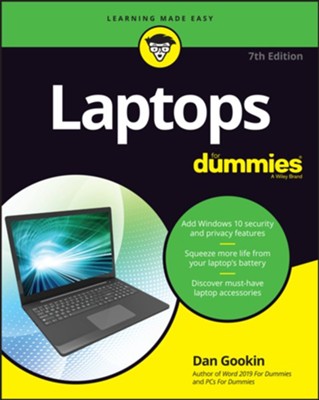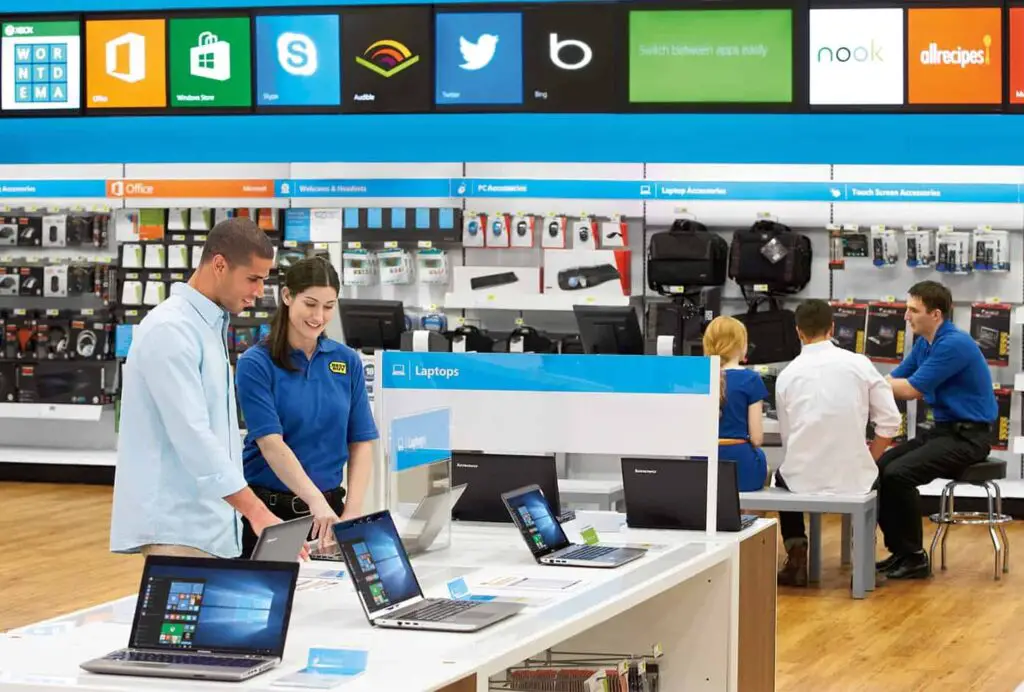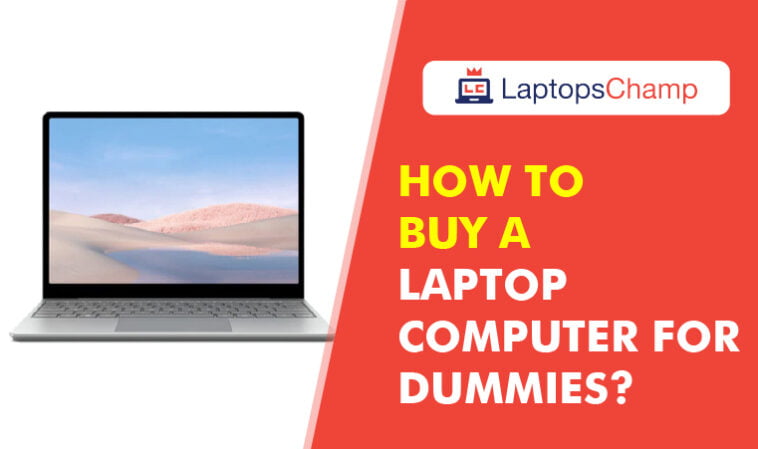Buying the right laptop for you to use might seem like a difficult task. After all, there are so many terms to take into consideration for the specifications of a laptop. And if you consider yourself a tech dummy, such random tech jargon could simply fly off your head.
Now a day people want different types of laptops such as gaming laptops with impressive operating systems. Modern laptops can be considered dedicated gaming laptops; certain features such as a dedicated graphics card, impressive laptop screen, dedicated graphics processors, and superior battery life are the features that people want in their laptops.
Of course, various factors will help you choose the best laptop that will suit all your needs. And no, you really shouldn’t buy a laptop just because it sports your favorite color.
But with our help, you don’t have to worry about not finding the best laptop for you to use, because this guide will help you how to buy a laptop computer for dummies.

Purpose
How to buy a laptop computer for dummies? Before anything else, you should first determine the type of work you mostly do on your laptop. Think about it. Your reason for purchasing a laptop should primarily depend on your needs.
Well, there’s certainly no harm in buying a high-end laptop if you’ll just mainly use it for light tasks as long as you have the money to do so, but you won’t be using your laptop to its maximum capabilities.
However, buying a low-end laptop for heavy video editing jobs and gaming could negatively affect your performance since such tasks require better specs for better processing speeds. Most laptop displays also lag to assist the tasks.
Size and Portability
Do you need to carry your laptop with you on the go? If so, then you must consider the size of your laptop as well. After all, carrying a bulky laptop with you isn’t so good. Do take note, though, that portable laptops do have smaller screens, which could not be to your liking at all.
Usually, laptops that are around 13 to 14 inches in size are the best size when you’re looking for a laptop that provides portability while still being decent in terms of size. After all, these laptops only weigh less than 4 pounds, making them easier to carry around.
Battery Life
There’s no need to worry about your laptop’s battery life as long as there’s an available outlet nearby. However, if you’re usually working in areas where you don’t often have the opportunity to charge your device, you should get a laptop that can last you for hours. Apple computers have impressive battery life; windows laptops also are good but not as good as business laptops like an apple.
Ideally, it’s best to purchase a laptop that can last for 9 to 10 hours or more. In addition, how you use your device will affect your laptop’s overall battery performance and life. So always make sure to check out the reviews about your selected laptop’s battery life.
Points to Keep in Mind while Buying a laptop
- These are the most crucial factors to take into account when selecting a new laptop. Check out the areas below for a lot more information.
- The most useful screen size for portability is between 12.5 and 14 inches. If you don’t travel much, larger screens are good, while smaller models are wonderful for youngsters.
- Aim for the following basic specifications if your budget exceeds $600: 1920 x 1080 screen, Core i5 or Ryzen 5 CPU, 8GB of RAM, and SSD storage in place of a hard drive.
- If you want to take your laptop anyplace at all, it should have a battery life of at least 9 hours.
- If you wish to use your laptop as a tablet, take into account a 2-in-1 laptop (either a bent back or detachable). In that case, a typical clamshell notebook might be a better option.
- Children and students benefit from using Chromebooks, and their usefulness is continually developing. Both MacBooks and Windows 10 laptops have a tonne of capability; your preference for one over the other depends on your preferences.
1. Choose a platform: Chrome OS, Mac, Windows 10, or another.
Answering this question is challenging, particularly if you are unfamiliar with both Macs and PCs. But this brief analysis of the advantages and disadvantages of each platform should be useful.
The three most common operating systems for laptops are Windows, Google’s Chrome OS, and macOS (for MacBooks only). A quick explanation of what each offers is provided here. The best option is a matter of personal preference.
Windows 10, the most adaptable operating system, operates on more laptop models than either macOS or Chrome OS. Windows notebooks come with a wide range of features, including touch displays, fingerprint scanners, and dual graphics chips, and can cost anywhere from $150 to several thousand dollars.
In comparison to Windows 7 and 8, Windows 10 offers several enhancements, such as the ability to convert between tablet and desktop modes, a new Start menu with Live Tiles, and the Cortana digital assistant.
discovered on low-cost Chromebooks like the Samsung Chromebook 3. Although more constrained than Windows or macOS, Google’s OS is straightforward and safe.
Although the main application you use is the Chrome browser, the user interface resembles Windows quite a bit with an application menu, a desktop, and the ability to move windows around.
The drawback is that a lot of the “web apps” you use don’t function effectively when used offline. All brand-new Chromebooks, including the premium Google PixelBook, can now run Android apps, so that is beginning to change.
Chromebooks are very portable, frequently have long battery lives, and are inexpensive if you need a device to browse the web, check email, traverse social networks, and talk online.
2. Choose a 2-in-1
Many PC laptops fall into the category of 2-in-1 laptops, hybrid devices that can switch between traditional clamshell mode, tablet mode, and other positions in between such as a tent or stand modes. 2-in-1s generally come in two different styles: detachable with screens that come off the keyboard entirely and flexible laptops with hinges that bend back 360 degrees to change modes.
Most of these systems are much better at serving one purpose than the other, with bend-backs being laptops first and detachable offering a superior tablet experience.
However, if you don’t see the need to use your notebook as a slate, you’ll usually get more performance for your money with a traditional clamshell laptop.
3. Select the Correct Size
Determine how portable you need your laptop to be before looking at specifications or costs. Display sizes are a common way to group laptops:
- 11 to 12 inches: Systems with 11 to 12-inch screens and average weights of 2.5 to 3.5 pounds are the smallest and lightest available.
- 13 to 14 inches: Offers the ideal portability and usefulness balance, especially if you get a laptop that weighs less than 4 pounds.
- The most common size, 15 to 16 inches, weighs 4 to 5.5 pounds in most cases. If you want a larger screen but don’t intend to carry your laptop around frequently, think about this size.
- Although 16-inch laptops are uncommon, Apple’s 16-inch MacBook Pro could spark a trend.
- A 17- or 18-inch machine could give you the processing power you need to play demanding games or perform workstation-level productivity if your laptop is left on your desk all day, every day.
4. Verify the keyboard and touchpad
If the laptop you’re buying lacks good ergonomics, even the most astounding specifications are worthless. Make sure the keyboard provides good tactile feedback, plenty of key travel (the distance the key moves down when pressed, typically 1 to 2mm), and adequate space between the keys if you anticipate using your computer for a lot of work.
Make sure the Windows laptop you’re purchasing has Precision touchpad drivers. Look for an accurate touchpad that responds consistently to multitouch actions like pinch-to-zoom and doesn’t produce a jumpy cursor.
Consider purchasing a business laptop with a pointing stick (also known as a nub) between the G and H buttons so you can use it to traverse the desktop without taking your fingers off the home row of the keyboard.
5. Choose Your Specs
You shouldn’t feel terrible if specifications look like an alphabet soup to you because even laptop experts sometimes get confused by components like the processor, hard drive, RAM, and graphics chip. The main elements to pay attention to are listed below.
CPU: The processor is the “brain” of your computer. It has a significant impact on performance, although depending on what you want to do, even the cheapest model might be adequate. Here is a summary:
The first-generation Tiger Lake processors from Intel’s 11th generation were released, and they will power the following generation of laptops. More information on these processors is available here. In conclusion, Tiger Lake, a 10-nanometer processor, has enhanced integrated Iris Xe graphics with up to 4.8 GHz rates as well as support for Thunderbolt 4.
The new EVO brand establishes requirements for high-end laptops, including a need for a battery life of at least 9 hours. Intel Core i9: Core i9 processors offer faster performance than any other mobile chip, dethroning the Core i7 as Intel’s top-of-the-line CPU.
Core i9 CPUs are only economically viable if you’re a power user who runs the most resource-intensive software and apps. They are only available on high-end laptops, workstations, and high-end gaming rigs.
Intel Core i7: An upgrade from Core i5, models with model numbers that finish in HQ or K use more power and have four cores, enabling faster productivity and gaming. Additionally, there are Core i7 Y series CPUs with less power consumption and performance.
Because they are part of Intel’s newest 10th and 11th Gen Generation Core Series and offer superior performance, keep an eye out for CPUs with a 10 in the model number. Intel Core i5:
Opt for a laptop with an Intel Core i5 CPU if you’re looking for a mainstream model that offers the best value and performance. The most prevalent models have a U at the end.
Models with a Y in the name are low power and perform poorer, whilst those with an HQ consume more power and are found in thicker gaming and workstation systems.
The most recent 11th Generation Tiger Lake CPUs from Intel contains four cores and a variety of practical features, such as improved AI, Thunderbolt 4 integration, and support for Wi-Fi 6.
Intel Core i3: Both the price and performance are only a notch below the Core i5. We advise upgrading to a Core i5 if at all possible.
Extremely pricey and powerful processors for large mobile workstations are called Intel Xeon. You might want a Xeon if you perform professional-level engineering, 3D modeling, or video editing, but you won’t get a lightweight laptop or outstanding battery life. Intel Pentium / Celeron:
Found frequently in laptops priced under $400, these chips provide the slowest performance, although they are adequate for web browsing and light document processing. You would be better off if you could spend extra money to get a Core i3 or i5.
Core m/Core i5/Core i7 from Intel, “Y Series:” These CPUs enable fanless systems due to their low heat and power consumption. Performance is a notch below the standard Core U series, but better than Celeron.
RAM: While it’s preferable to have at least 8GB of RAM on even a budget machine and 16GB if you have a little extra money to invest, some sub-$250 laptops only have 4GB of RAM. Most people need 32GB or more, while heavy users should only utilize 64GB or higher.
The performance of your storage drive is even more crucial than the processing power of your CPU. Get a laptop with a solid-state drive (SSD) rather than a hard drive if you can afford it and don’t want a tonne of internal storage because you’ll experience at least three times the speed and a significantly speedier laptop overall.
The newest PCIe x4 (also known as NVME) SSD devices offer three times the speed of older SATA drives. Although eMMC memory is theoretically solid-state, mechanical hard drives are still quicker than it in sub-$250 laptops.
Display: More pixels allow you to fit more content on the screen and improve the sharpness of the image. Sadly, some business laptops and economy laptops still feature screens with a resolution of 1366 x 768, but if you can afford it, we suggest spending extra money for a panel that operates at 1920 x 1080, often known as Full HD or 1080p.
High-end laptops offer displays with resolutions of 2560 x 1600, 3200 x 1800, or even 3840 x 2160 (4K), all of which look brilliant but use more power, reducing battery life.
Resolution is only one aspect of display quality. Read our reviews to find out if the laptop you’re considering has a good display. IPS screens vary in color and brightness.
Usual criteria include results with an sRGB color rating of over 100% and brightness greater than 300 nits.
Consider an OLED panel if you want the finest picture quality and don’t worry about battery life. Additionally, keep a look out for emerging display technologies like mingled that will be used in laptops.
Touch Screen: You won’t get much use out of a touch screen and will receive 1 to 2 hours less battery life if you get a standard clamshell laptop as opposed to a 2-in-1. Touch screens are standard on 2-in-1s. Visit our best touchscreen laptops page if you insist on having a touch screen.
Graphics Chip: An integrated graphics chip (one that shares system memory) will work great if you aren’t editing high-resolution videos, playing PC games, or creating 3D objects.
This includes Intel’s newest Iris Xe graphics. However, a standalone graphics processor from Nvidia or AMD is necessary if you have any of the aforementioned requirements.
There are high-end and low-end graphics processors, similar to CPUs. Nvidia MX450 or GTX 1660 GPUs are typically found in low-end gaming or workstation systems nowadays, whereas RTX 2050 or RTX 2060 GPUs are found in mid-range models and RTX 3070 or 3080 GPUs are found in high-end models. From entry-level to high-end, Nvidia has a list of graphics processors.
Ports: While a laptop’s lack of ports is typically not a deal-breaker, having the connections you require on the device rather than having to carry a variety of dongles is useful.
The majority of common laptops will offer HDMI video output and USB 3.0 connections. The USB Type-C connector or the Thunderbolt 3 and Thunderbolt 4 ports, which are USB Type-C compatible, are used by an increasing number of computers.
Having Type-C means you can use it to connect to universal chargers and docks, which is undoubtedly advantageous. If you have the patience, USB 4 will soon be available, offering quicker transfer speeds and the option to daisy-chain 4K monitors together using a single connection. Headphone jacks, Ethernet ports, and SD card slots are additional handy connections.
Connectivity: Look for a laptop that supports 4G LTE or 5G if you need to use your computer on the go. Although a data subscription plan will cost money, it will let you access the internet without a router. Find a laptop that supports Wi-Fi 6 if you want the newest and best networking possibilities. In comparison to 802.11ac, Wi-Fi 6 delivers higher theoretical throughputs and a more reliable connection.
Additionally, we advise searching for a laptop that supports Bluetooth 5, the most recent standard that provides better interaction with Bluetooth-enabled devices like mice and headphones.
DVD/Blu-ray Drives: Since all software and movies can be downloaded, few laptops come with optical drives, but we have kept note of the models that do.
However, if your preferred laptop doesn’t have a built-in DVD drive and you need to read/write discs, you can always spend less than $20 on an external DVD drive that connects by USB.
6. Do not shortchange battery life
You don’t need to worry about battery life if you’re buying a big, clunky notebook or a gaming setup that you’ll solely use on a desk next to an outlet.
However, you’ll need at least 7 hours of endurance, with 8+ hours being optimal, if you intend to use the laptop on your lap, whether it’s at home or work.
Don’t rely just on a notebook maker to tell you how long the battery should last. Read independent research from reliable sources, such as our reviews, as an alternative.
7. Beware the Brand
Your laptop’s manufacturer determines how good it is. Laptop Mag examines each major brand in our yearly Tech Support Showdown because quick and accurate technical support is crucial. Last year, Apple won the top spot, followed by Razer, the big news of the year, and Dell to complete the top three.
Support is simply one factor that contributes to a notebook brand’s value. You must also take into account how the manufacturer compares to the competitors in terms of design, value, and selection, as well as other factors like performance.
HP came out on top in our research on the Best and Worst Laptop Brands for 2020, followed by Asus and Dell. We also ranked gaming laptop brands, with MSI coming out on top, followed by Acer and Alienware.
What are the specifications of a good laptop?

Next, our guide on how to buy a laptop computer for dummies is to consider the specs of your preferred laptop. Depending on the kind of work you will be doing on your laptop, your preferred laptop must have the required specs to get your job done efficiently. Here are the following specifications you should look for in a laptop.
1. Processor
The processor or the central processing unit (CPU) determines how swiftly your device processes instructions. Nowadays, cores usually come in two, four, or six cores. And the more cores a device has, the quicker the device can accomplish such tasks in a period.
For instance, high-end computer laptops usually have Intel cores i7 or i9 for optimal performance. They can get a little pricy, but you’ll be seeing why they’re so worth it in the long run.
2. Graphics Card
Most of the time, you won’t need to invest in a laptop with high-end graphics. However, if you’re mainly using your laptop for gaming or editing purposes, then getting a laptop with a decent or superior graphics card will significantly help you with your work
There are a variety of graphics cards ranging from low-end types to superior ones. Of course, the high-end graphics cards will cost more but will offer better performance.
3. Storage
It’s better to choose laptops with more storage, especially when you’re frequently storing large chunks of files on your laptop. Nowadays, it’s highly recommended that you go for laptops that use solid-state drives (SSDs).
SSDs offer quicker loading times for all applications, games, and the like, compared to standard Hard Disk Drives (HDDs). However, SSDs are a bit more expensive, but their better load times make all the difference.
4. Random Access Memory (RAM)
Buying a laptop with more RAM is highly recommended, and any laptop that contains RAM lesser than 8 GB shouldn’t be used for heavy tasks like video editing.
Ideally, it’s best to get a laptop with at least 8 GB of RAM size for better performance. But if you’re doing much heavier tasks like gaming, video or photo editing, and the like, then it’s recommended to go for 16 GB or higher, depending on how demanding your workload can get.
5. Ports
Be sure to check if your preferred laptop has all the slots you need. From the essential USB ports, HDMI ports, audio jack, etc. You may also want to check if your laptop has a usable SD card slot so you can easily transfer photos from your camera.
6. Display
You might also want to factor in your preferred laptop’s display. Additionally, you might also want to go for laptops with higher resolution.
Resolution refers to the pixels which comprise the images you can see on your screen. After all, more pixels mean sharper displays.
The ideal display for most laptops out there offers 13 inches of screen displays. On the other hand, the recommended laptop computer resolutions are around 1280 x 800 pixels for laptop screens ranging from 13 to 15 inches in size.
7. CD or DVD Drives
While some laptop models still come with CD or DVD drives, most laptops usually don’t have this feature anymore due to the popularity of downloadable movies online instead.
If you’re unable to find a laptop that offers everything you want in a laptop but not the feature that you need, ordering an external drive should easily solve your problem.
Budget
Next, you should first consider how much money you are willing to spend on a laptop. As previously mentioned, the specifications your work demands will affect your overall budget, so laptops with better specs and performance will cost more.
For instance, low-end laptops with minimum storage and slower CPUs will not cost you that much and are simply ideal for accomplishing minimal tasks such as simple documentation or surfing the web. These laptops will cost around $250 or less.
If you want a decent laptop with better specs that can do more than a low-end laptop, you will have to shell out around $350 to $600.
On the other hand, laptops costing around $600 or higher will sport more premium features and contain the most up-to-date laptop specifications. Indeed, they are costly, but their inclusion of high-end specs makes them worth it for their price.
Laptop Design
When we say laptop design, we don’t just mean the color of a laptop and such. The overall appearance of your (like the color) should be the least of your priorities. F
For instance, when choosing a laptop to buy, ensure that the keyboard is comfortable to use and the keys are adequately spaced from each other.
Moreover, does the laptop have a decent trackpad? According to your preference, you might also want a laptop that makes use of a pointing stick (that button found in between the letters G and H on your keyboard). Additionally, are the features easy to figure out on your own?
To put it in a nutshell, make sure to think about all these things that will make using your laptop much more convenient for you. After all, what’s the point in purchasing a laptop that doesn’t spark joy when you use it?
Operating System
Laptops mostly offer the following Operating Systems (OS): Windows, Mac, and Chrome OS. Mac Operating Systems are exclusive to Apple devices, while Windows Operating Systems are widely available among several laptop models.
Choosing your preferred OS is just a matter of preference, but still, you should consider working with a laptop whose OS is the one you’re most familiar with or an OS you preferably want to use.
Conclusion
This finishes our simple guide on how to buy a laptop computer for dummies. Now that you have a good idea of properly purchasing a laptop, it shouldn’t be so hard for you the next time you walk inside a computer store or visit an online shop for laptops.
Yes, it can get intimidating to go into a deep dive into everything we’ve discussed previously, but these should be the basic things you need to know when you want to invest in a better laptop suited for all your needs.
And if you’re still not sure if you understood things right, you can always ask for the assistance of other tech nerds ad professionals out there. After all, you can easily ask for recommendations in online forums, communities, and more.





